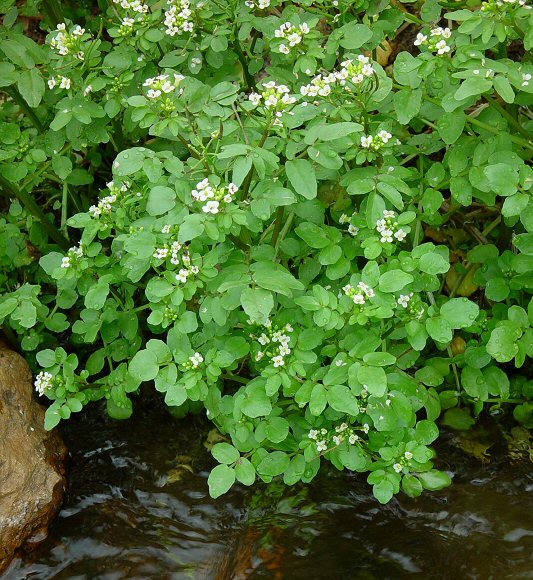
Blossoming, peppery watercress.
Watercress/Wintercress grew in a ditch behind an apartment complex I lived in near Sanford, Florida, some 30 years ago. How did the Eurasian native Nasturtium officinale, get there? It came to North America with the Europeans, found a good home, and stayed. Alabama later became the epicenter of cultivating it after Central Florida. The city of Sanford, by the way, is named for Henry Sanford one of Lincoln’s ambassadors. He is called “General Sanford” but the gentleman never served in the military. He got the title for donating a cannon to the Union effort. Sanford was, however, big on big farming and for a few decades made the city of Sanford the big place to go in Central Florida.
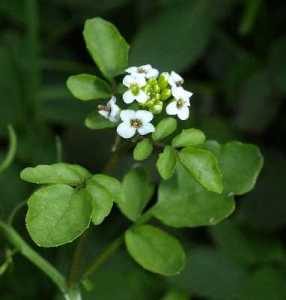 When President Calvin Coolidge came to Central Florida in 1929 it was to Sanford (and Lake Wales) he went not little-ol’ backwater Orlando. The city of Sanford had everything: River, rails, road even a college (Rollins which later moved to Winter Park.) Sanford however lacked leadership giving Orlando a chance to make its mousey mark. The watercress was in the ditch behind the apartment complex because the entire area was once truck farms and one of their main winter crops was watercress. Peppery like nasturtiums it is edible raw or cooked but make sure you get it from wholesome water. Nasturtium by the way literally means “twisted nose.” Where I collect watercress to be eaten raw is about a half mile down stream from the Wekiva River boil (its main spring and headwater.) But there’s a lot of water hemlock around so I have to pick carefully. To read more about watercress go here. To read about the deadly Water Hemlock go here.
When President Calvin Coolidge came to Central Florida in 1929 it was to Sanford (and Lake Wales) he went not little-ol’ backwater Orlando. The city of Sanford had everything: River, rails, road even a college (Rollins which later moved to Winter Park.) Sanford however lacked leadership giving Orlando a chance to make its mousey mark. The watercress was in the ditch behind the apartment complex because the entire area was once truck farms and one of their main winter crops was watercress. Peppery like nasturtiums it is edible raw or cooked but make sure you get it from wholesome water. Nasturtium by the way literally means “twisted nose.” Where I collect watercress to be eaten raw is about a half mile down stream from the Wekiva River boil (its main spring and headwater.) But there’s a lot of water hemlock around so I have to pick carefully. To read more about watercress go here. To read about the deadly Water Hemlock go here.
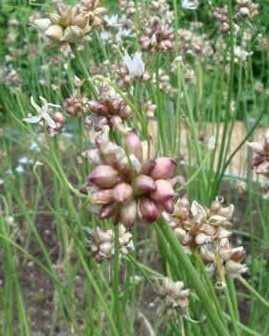
Wild Garlic cloving.
After Watercress the second plant in profusion now is Wild Garlic. It’s putting on cloves. Wild Garlic is always a delightful find; pungent, sharp, tasty. You just know it was a welcomed spring green and flavored many an ancient meal. After a little drying I store the cloves in the frig in a paper bag. The onions go in the bin for more immediate use. You can collect them in profusion this time of year. Look for them in damp spots but not waterlogged. Wild garlic, also called wild onion, is unusual in that it puts cloves on the top of its stem, not underground on the bottom. (Onions put on a bulb, garlic puts on cloves.) This wild Allium also puts on marble-to-ping-pong ball size onions underground, about four inches down or so. It hides most of the year. To read more about the wild garlic, click here. I have a video here.
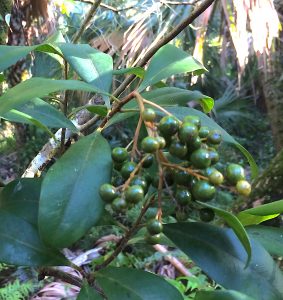
Unripe Marlberries.
Marlberries and I don’t meet too often, about once or twice a year and then usually while I’m conducting a class so I don’t have the time to get acquainted better. There is also a certain lack of motivation because even at its best marlberry is not a great trailside nibble. A complicating headache is there are several Malberries of varying quality. They are also related to the invasive species Coral Berry, Ardisia crenata, which has been implicated in cattle poisoning. Reportedly found mid-Florida and south I have found Marlberries in Dreher Park in West Palm Beach, LaStrange Preserve in Ft. Pierce, and Emerson Point near Sarasota. Around the same time and in the same habitat you find Marlberries you can also see Rapanea punctata, Colicwood, one of those mystery pants one finds in wet woods. It looks like a drab cross between a mangrove and a beautyberry and used to be called Myrsine guianensis. Colicwood’s small yellow blossoms and black fruit grow directly on the branches, helping you identify it. There’s not a whole lot of literature on the species so the berries are probably not edible. As it is called “Colicwood” suggest some medicinal uses. To read more about the Marlberry and its strange relatives go here.
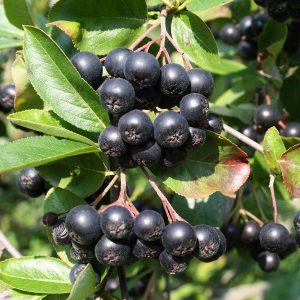
Bitter Aronia berries.
Another possible local species that needs more study is Aronia also called Chokeberry (note it is chokeBERRY not chokeCHERRY.) They are common in the Carolinas particularly on the Appalachian Trail where they get the 800 or so chill hours they need each winter. The berries are a powerhouse of anti-oxidants. Like Morels they shouldn’t be found in Florida as it just does not get cold enough long enough here but yet… In Gainesville, Florida, I have seen a species that might be A. melanocarpa. Here at EatTheWeeds we use I.T.E.M. and E is for environment which includes climate and Florida is the wrong environment for the species. However, if you plant Aronias they will grow here and apparently fruit. It has been reported in Hawthorne Fl. which is 20-some miles down the road from Gainesville. In this case they are growing with a profusion of Deerberries near the Hawthorn Trail which are blossoming now and were mentioned in this newsletter. Perhaps the Aronia was intentionally planted many years ago.
Foraging classes, at least for this week, are on hold. Private classes are ongoing but I need to find what public areas are still open. The closings are not consistent. Sanlando Park in Seminole County is open but all the city parks in nearby Altamonte Springs are closed. Some federal land is ope, some closed. We will get back to normal.
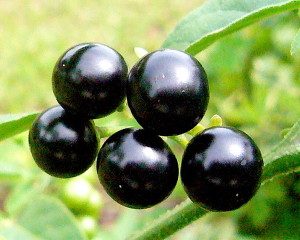
The Black Nightshade has berries. Photo by Green Deane
The American Nighshade is a much-maligned plant. Whether discussing its name, Solanum americanum, or edibility there can be confusion. The flavor of American Nighshade berries ranges from mild to slightly sweet, non-descript to pleasant, not bitter. It’s fairly easy to identify: The toxic unripe berries are green, shiny, mottled and flecked with white. They cluster at one point on the end of the peduncle (stem.) Then they turn deep purple, shiny and edible. Also you can find blossoms with petals that fold down and backwards rather than upward and around the middle. But you have to be careful. Not far from the pictured fruit I found another nightshade, similar looking. The unripe berries were clustered at the end of the peduncle but they were not shiny, mottled or flecked with white. They were a dull green. And the ripe berries were larger than usual and a dull black. Their taste was bitter. I think I run into a wayward species occasionally, from Deland to Ocala. The dull look to the berries and their larger than usual size are a good tip off and of course when ripe they taste bitter. One possibility is Solanum chenopodioides but I’m not certain of that. I just avoid it. You can read about the American Nightshade here.
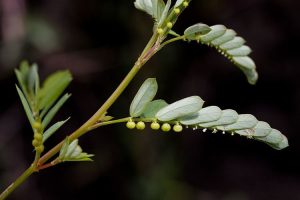
Chamberbitter, Phyllanthus urinaria.
I don’t write about herbal uses because I am not qualified to do so. As I say in my classes that’s beyond my pay grade. My expertise is edible plants and I also know a lot of herbalists who would take me to task if I proffered too much advice about herbals. Still, one can’t ignore them either. In my classes if I know an herbal application I mention it but I also advise folks to check with their local herbalist. That said one common herb I see is Chamberbitter, or Stonebreaker, Phyllanthus urinaria. There are about a dozen and a half Phyllanthus in Florida. Fortunately the one we want is fairly easy to identify. The seeds line up on the underside. The species has been used a long time for urinary issues including kidney stones. But recent research suggests it can have far more applications. According to a 2018 journal article “… investigations reveal that the plant is a rich source of lignans, tannins, flavonoids, phenolics, terpenoids, and other secondary metabolites. Pharmacological activities include anticancer, hepatoprotective, antidiabetic, antimicrobial, and cardioprotective effects.”

Green Deane Forum
Want to identify a plant? Perhaps you’re looking for a foraging reference? You might have a UFO, an Unidentified Flowering Object, you want identified. On the Green Deane Forum we — including Green Deane and others from around the world — chat about foraging all year. And it’s not just about warm-weather plants or just North American flora. Many nations share common weeds so there’s a lot to talk. There’s also more than weeds. The reference section has information for foraging around the world. There are also articles on food preservation, forgotten skills from making bows to fermenting food. Several hard-to-find books are there page for page. Recent posts this week include Spring 2020 Plantings, Light Purple Flowers and Fuzzy Leaves, Red Blossoms Hanging Down, Edible Privacy Fence, Tendrilizing, Calculating COVID-19 Mortality Rate, Nettle Spanakopita, Pawpaws Starting Early? What are those White Blossoms, Brazilian Pepper Revisited, Palmer Amaranth, In The Loop, Tomatoes: A Fruit First, a Vegetable Second, and Butterweed: Annual Warning. You can join the Forum by going to the upper right hand top of this page.
 Donations to upgrade EatTheWeeds.com have gone well. Thank you to all who have contributed to either via the Go Fund Me link, the PayPal donation link or by writing to Green Deane POB 941793 Maitland FL, 32794. There are many needs left such as expanding the foraging teacher page and the page on monotypic edibles. There’s always something and such things get more complex and expensive every year.
Donations to upgrade EatTheWeeds.com have gone well. Thank you to all who have contributed to either via the Go Fund Me link, the PayPal donation link or by writing to Green Deane POB 941793 Maitland FL, 32794. There are many needs left such as expanding the foraging teacher page and the page on monotypic edibles. There’s always something and such things get more complex and expensive every year.
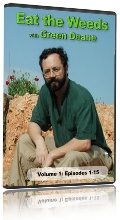 Though your foraging may drop off during Covid-19 travel bans it’s a great time to study wild edibles with my nine DVD set. Each DVDs has 15 videos for 135 in all (that’s $1 a video.) They make a great gift. Order today by the set or individual videos. Some of these videos are of better quality than my free ones on the Internet. They are the same videos but many people like to have their own copy. I burn and compile the sets myself so if you have any issues I handle them personally. There are no middle foragers. I also made more to cope with the quarantines and replace lost class income. To learn more about the DVDs or to order them click here.
Though your foraging may drop off during Covid-19 travel bans it’s a great time to study wild edibles with my nine DVD set. Each DVDs has 15 videos for 135 in all (that’s $1 a video.) They make a great gift. Order today by the set or individual videos. Some of these videos are of better quality than my free ones on the Internet. They are the same videos but many people like to have their own copy. I burn and compile the sets myself so if you have any issues I handle them personally. There are no middle foragers. I also made more to cope with the quarantines and replace lost class income. To learn more about the DVDs or to order them click here.
This is weekly newsletter 400… something of a milestone… some might say millstone around the neck. The original newsletters were monthly and started about a decade ago. If you want to subscribe to this free newsletter you can find the sign-up form in the menu at the top of the page.
To donate to the Green Deane Newsletter click here.


I’m all about staying healthy but for the life of me I cannot understand why they shut down county state and federal parks and Management areas etc. There’s never that many people in any of these places fresh air Sunshine spring water exercise heat humidity you name it one thing we ought to be doing is getting out and getting healthy it’s so ridiculous it’s so Overkill. But no let’s stay inside making each other irritable and sick sorry rant over. Forage on